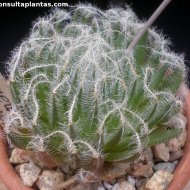Care of the succulent plant Haworthia arachnoidea or Cobweb aloe |
|
The genus Haworthia, family Asphodelaceae, includes 100 species of succulent plants native to southern Africa. Some species are: Haworthia arachnoidea, Haworthia viscosa, Haworthia turgida, Haworthia truncata, Haworthia retusa, Haworthia reinwardtii, Haworthia pumila, Haworthia marumiana, Haworthia limifolia, Haworthia herbacea, Haworthia attenuata, Haworthia angustifolia, Haworthia variegata, Haworthia fasciata, Haworthia cooperi, Haworthia cuspidata. Common name: Cobweb aloe. Scientific synonym: Haworthia semiviva. This species is native to Northern and Western Cape, South Africa. They are small succulent plants without a stem and leaves arranged in a rosette that reach 10 cm (3.93") in height; sometimes produces suckers. The thin, light green leaves have white bristles on the margins; the tips of the leaves dry up in summer. They produce long inflorescences up to 30 cm (11.8") tall with white and green flowers. Due to its small dimensions, Cobweb aloe is often used in pots for balconies, terraces, patios and as indoor plants located near a window. Haworthia arachnoidea prefers a semi-shade exposure receiving direct sun in the morning. It does not resist frost. The soil can be a commercial substrate for cacti and succulent plants. Transplant every 2-3 years in early spring to renew the substrate. Water moderately in winter waiting for the substrate to dry completely. In spring and autumn water occasionally. In summer do not water because it comes to rest. Cobweb aloe does not need fertilizer or pruning. Haworthia arachnoidea is a plant quite resistant to the usual pests and diseases but sensitive to excessive humidity. Haworthia semiviva is propagated from seeds sown in autumn in the nursery and by separating suckers (if it produces them). |
Images of the succulent plant Haworthia arachnoidea or Cobweb aloe |
Find plants
Haworthia arachnoidea or Cobweb aloe | Care and Growing
© 2025 FavThemes
